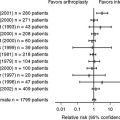Chapter 25 What Is the Best Treatment for Wrist Fractures?
Pediatric wrist fractures may be classified based on the level of injury and the degree of soft-tissue damage (Table 25-1). The level of injury may be physeal or metaphyseal. Physeal injuries may be further subdivided into Salter–Harris type I and II injuries. The literature demonstrates that the majority of physeal injuries at the wrist are Salter–Harris type II.1 Metaphyseal fractures may be subdivided into torus (buckle fractures), greenstick, and complete fractures. Complete fractures may be angulated, translated, or completely displaced with shortening. Most wrist fractures in the pediatric age group are closed injuries. Open fractures, which indicate a greater degree of soft-tissue damage, may increase the risk for complications including loss of reduction, infection, and growth arrest.
TABLE 25-1 Classification of Pediatric Wrist Fractures
An extensive review of recent English-speaking orthopedic literature from 1997–2007 was undertaken to identify areas of uncertainty and to determine the best evidence available to justify the current treatment of wrist fractures in the pediatric age group. This search identified five articles that reach evidence level I or II (Journal of Bone and Joint Surgery combined volumes [JBJS] Levels of Evidence for Primary Research Question).2,3 Three of these five articles concern management of torus fractures of the distal radius.4–6 Eleven more articles reached levels of evidence III and IV.
Torus Fractures
By definition, torus fractures are incomplete fractures with a failure of the cortex on the compression side of the bone. The convex (or tension side) cortex remains intact. These are stable injuries, and five articles support a minimalist approach to management of these injuries.4–9
Three randomized clinical trials addressed the subject of torus fractures. Davidson and colleagues4 randomized 201 patients to treatment with a cast versus a removable “Futura-type” wrist splint for 3 weeks with no difference in outcome as measured by a mail-in questionnaire. Plint and coauthors5 found similar results using a validated outcome tool—the Activities Scales for Kids performance version (ASKp). This study reported better functioning in the splint group, with less interference with bathing. Symons and coworkers6 reviewed 87 patients treated with splints to assess home management versus standard hospital follow-up. Forty patients who had their splints removed at home were compared with 47 patients treated by removal of the cast in the orthopedic clinic. Results were similar between the groups, but both groups, if given the choice, would prefer removal of the splint at home. Several authors believe there is no evidence that further follow-up is needed after splint removal.4,6
Several articles report cost savings with these minor injuries, because of fewer clinic and physician visits, fewer radiographs, and a reduction in family’s time lost from school and work.4,6–8
Displaced Fractures
After achievement of adequate analgesia, a closed reduction and immobilization of the wrist and forearm in a well-molded, short-arm plaster of Paris or fiberglass cast is the accepted treatment and standard of care for displaced fractures.10,11 Analgesia in the emergency department may be in the form of intravenous regional anesthesia (Bier block) or intravenous sedation with narcotics and benzodiazepines. Numerous case report studies in the orthopaedic literature (levels of evidence IV and V) confirm the safety and efficacy of various techniques for regional or general pain control during fracture manipulation.12
Displacement Limits Postreduction
Limits on what is considered an acceptable reduction vary with the bone involved, the direction of displacement, and patient age. Remodeling after malunited wrist and distal forearm fractures in children is common and often dramatic. Price and researchers10 have previously demonstrated the remodeling potential in malunited forearm fractures in childhood. Only six of their patients had distal third fractures, but they believed that “distal fractures have a more favorable prognosis” than diaphyseal injuries.13 Do and colleagues14 demonstrated in 34 pediatric metaphyseal wrist fractures that all healed within an average of 6 weeks and completely remodeled within an average of 7.5 months. They recommend that angulation in either plane (coronal or sagittal) of less than 15 degrees, and shortening of less than 1 cm, are acceptable limits and consistent with a normal functional outcome. They also demonstrated a significant cost saving (50%) compared with the patients who were managed with formal reduction and casting. Zimmermann and coauthors15 have shown equal remodeling potential for dorsal and volar displaced wrist fractures.
The literature defining acceptable limits for displacement after reduction is, in the majority, level III (case–control study)14–16 or IV (case series).17,18 No randomized clinical trials (levels of evidence I and II) address this question, although most practicing pediatric orthopedic surgeons are inclined to accept up to 15 degrees of angulation in the sagittal plane and slightly less deformity in the coronal plane. Translation, especially in the coronal plane, with encroachment on the interosseus space is less likely to be accepted. Age of the patient is also an important parameter in determining limits of malreduction, recognizing the greater remodeling potential of the younger child. A randomized clinical trial would be required to more definitively address the limits of acceptable displacement (amount and plane of deformity) that are consistent with good clinical outcomes, and how these limits are modified by the age of the patient.
Cast Treatment after Fracture Reduction
Immobilization in a short-arm cast will prevent loss of reduction as long as cast molding is adequate. Three articles confirm the cast index (the ratio of the cast dimension, at the level of the fracture, on the anteroposterior vs. lateral radiograph) as a predictor of loss of reduction.10,11, 15 Webb and investigators10 demonstrate a direct correlation between higher cast indices (indicative of poor cast molding) and loss of reduction. This study also demonstrates that a well-molded short-arm cast is just as effective at maintaining reduction as long-arm casts for fractures in the wrist and distal third of the forearm. Short-arm casting also resulted in fewer lost school days and reduced need for assistance with activities of daily living.10 Bhatia and researchers1 demonstrated a further reduction in redisplacement rates by improvement in casting technique.
Indications for Open Reduction or Internal Fixation
Indications for open reduction of pediatric wrist fractures include failure to achieve or maintain an adequate closed reduction. For fractures with significant instability, which may not be held reduced with external cast immobilization, smooth pin fixation is indicated.19 Although these principles are generally accepted in the orthopedic texts and literature, the levels of supporting evidence in the literature are generally no higher than level III or IV. One randomized clinical trial (level of evidence I) compared cast immobilization with percutaneous pin fixation for pediatric distal radius fractures. This was a small study (34 patients) that found a similar short-term complication rate with both methods of treatment, but the complications were different: patients with casts had a high rate of loss of reduction (39%), whereas the pinned patients developed pin tract problems (38%). At long-term follow-up, there were no differences in results between the treatment groups.20
Open Fractures
Grade 1 open wrist fractures are managed with conscious sedation, slight enlargement of the wound with adequate irrigation in the emergency department, followed by closed reduction and casting. A short course of antibiotics and early inspection of the wound result in low complication rates. Grade 2 and 3 open injuries with a greater degree of soft-tissue injury should be débrided in the operating room, with consideration given to delayed closure to reduce the risk for deep infection. Again, levels of supporting evidence in the literature, for management of open fractures, are levels III to IV.16 Many years of clinical experience, and low complication rates in the level IV series, which do exist, support continuation of these management protocols. Table 25-2 provides a summary of recommendations for the treatment of wrist fractures.
| STATEMENT | LEVEL OF EVIDENCE/GRADE OF RECOMMENDATION | REFERENCES |
|---|---|---|
1 Bhatia M, Housden PH. Re-displacement of paediatric forearm fractures: Role of plaster moulding and padding [erratum appears in Injury. 2006 Aug;37(8):801]. Injury. 2006;37:259-268.
2 Bhandari M, Swiontkowski MF, Einhorn TA, et al. Interobserver agreement in the application of levels of evidence to scientific papers. J Bone Joint Surg Am. 2004;86:1717-1720.
3 Wright JG, Swiontkowski MF, Heckman JD. Introducing levels of evidence to the journal. J Bone Joint Surg Am. 2003;85:1-3.
4 Davidson JS, Brown DJ, Barnes SN, Bruce CE. Simple treatment for torus fractures of the distal radius. J Bone Joint Surg Br. 2001;83:1173-1175.
5 Plint AC, Perry JJ, Correll R, et al. A randomized, controlled trial of removable splinting versus casting for wrist buckle fractures in children. Pediatrics. 2006;117:691-697.
6 Symons S, Rowsell M, Bhowal B, Dias JJ. Hospital versus home management of children with buckle fractures of the distal radius. A prospective, randomised trial. J Bone Joint Surg Br. 2001;83:556-560.
7 Meier R, Prommersberger K-J, van Griensven M, Lanz U. Surgical correction of deformities of the distal radius due to fractures in pediatric patients. Arch Orthop Trauma Surg. 2004;124:1-9.
8 Solan MC, Rees R, Daly K. Current management of torus fractures of the distal radius. Injury. 2002;33:503-505.
9 Van Bosse HJP, Patel RJ, Thacker M, Sala DA. Minimalistic approach to treating wrist torus fractures. J Pediatr Orthop. 2005;25:495-500.
10 Webb GR, Galpin RD, Armstrong DG. Comparison of short and long arm plaster casts for displaced fractures in the distal third of the forearm in children. J Bone Joint Surg Am. 2006;88:9-17.
11 Bohm ER, Bubbar V, Yong Hing KY, Dzus A. Above and below-the-elbow plaster casts for distal forearm fractures in children. A randomized clinical trial. J Bone Joint Surg Am. 2006;88:1-8.
12 Colizza WA, Said E. Intravenous regional anesthesia in the treatment of forearm and wrist fractures and dislocations in children. Can J Surg. 1993;36:225-228.
13 Price CT, Scott DS, Kurzner ME, Flynn JC. Malunited forearm fractures in children. J Paediatr Orthop. 1990;10:705-712.
14 Do TT, Strub WM, Foad SL, et al. Reduction versus remodeling in pediatric distal forearm fractures: A preliminary cost analysis. J Pediatr Orthop Part B. 2003;12:109-115.
15 Zimmermann R, Gschwentner M, Pechlaner S, Gabl M. Remodeling capacity and functional outcome of palmarly versus dorsally displaced pediatric radius fractures in the distal one-third. Arch Orthop Trauma Surg. 2004;124:42-48.
16 Luhmann SJ, Schootman M, Schoenecker PL, et al. Complications and outcomes of open pediatric forearm fractures. J Pediatr Orthop. 2004;24:1-6.
17 Cannata G, De Maio F, Mancini F, Ippolito E. Physeal fractures of the distal radius and ulna: Long-term prognosis. J Orthop Trauma. 2003;17:172-180.
18 Kiely PD, Kiely PJ, Stephens MM, Dowling FE. Atypical distal radial fractures in children. J Pediatr Orthop B. 2004;13:202-205.
19 Choi KY, Chan WS, Lam TP, Cheng JC. Percutaneous Kirschner-wire pinning for severely displaced distal radial fractures in children. A report of 157 cases. J Bone Joint Surg Br. 1995;77:797-801.
20 Miller B, Taylor B, Widmann R, et al. Cast immobilization versus percutaneous pin fixation of displaced distal radius fractures in children: A prospective, randomized study. J Pediatr Orthop. 2005;25:490-494.







